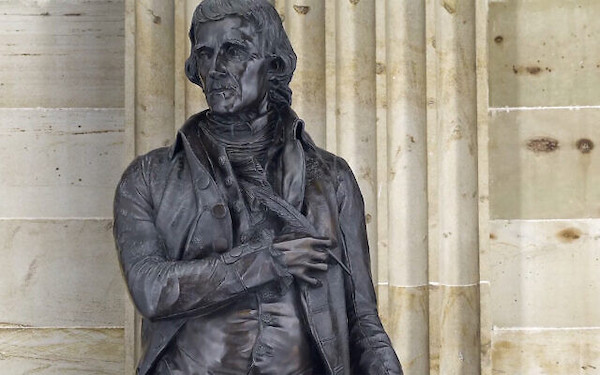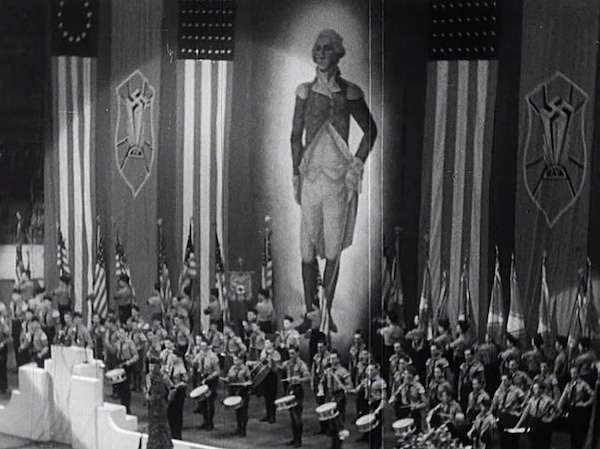DocTalk: Five Documentaries Probe the Past at The National Center for Jewish Film’s Annual Festival
By Peter Keough
Four features and one short that explore aspects of Jewish history from its impact on the earliest origins of the United States to the ongoing struggles of the state of Israel.
As the name suggests, one of the purposes of documentary film is to document history. It’s a goal admirably fulfilled by these documentaries screening in The National Center for Jewish Film’s Annual Film Festival (through 23 at the Coolidge Corner Theatre), four features and one short that explore aspects of Jewish history from its impact on the earliest origins of the United States to the ongoing struggles of the state of Israel.

In the 1830s, Uriah Levy commissioned a bronze statue of Thomas Jefferson that still stands in the US Capitol. It is the only statue gifted by an individual to do so. Photo: courtesy of PerlePress Productions
As is pointed out in Steve Pressman’s fascinating feature The Levys of Monticello (2022; screens May 8 at 5 p.m. with a Q&A with the director and Brandeis professor Jonathan Sarna, an interviewee in the film), the mansion of the title is, next to the White House, perhaps the most famous residence in the United States. Home to Thomas Jefferson, author of the Declaration of Independence, second President of the United States, and a Virginia slave owner, Monticello embodies much of what is best and worst about the country he helped found. Few know that, for nearly a century — longer than the Jeffersons themselves lived there — it was the residence of the family of Uriah Phillips Levy, a fifth-generation American Jew and a U.S. Naval officer, and of his nephew Jefferson Monroe Levy, a wealthy financier.
Jefferson, who was a genius in many fields but not in business, died in 1826 in such debt that his family tried to sell Monticello to avoid bankruptcy. The elder Levy bought the estate in 1834 and found it had fallen into disrepair. He restored it, but when the Civil War broke out and Levy remained loyal to the Union, his property was confiscated by the Confederacy. Levy died in 1862 and after the war ownership of the estate was disputed by his heirs until the younger Levy bought them all out in 1879 and restored the once again decrepit grounds and mansion. He resisted for years a campaign to have the Federal government seize the place, a movement fomented by bigots outraged that this iconic American landmark was owned by a Jew. Finally, faced with financial reversals, he sold it in 1926.
Pressman keeps track of these decades of complicated transactions with uncluttered clarity and also doesn’t shy from the murky issues of racism and anti-Semitism that are raised. Uriah Levy admired Jefferson’s ideals of religious liberty but he too was a slave owner, though he condemned the Confederacy as treasonous. And, as the film notes at the end, the atavistic hatred of Jews that Levy’s nephew faced would surge anew in 2017 during the Unite the Right rally just down the hill in Charlottesville. There thousands of torch-wielding White Nationalists marched and chanted “Jews will not replace us!”
Similar images of massed fascists mark Marshall Curry’s A Night at the Garden (2017; screens May 8 at 7:30 p.m. with the 1948 film noir Open Secret and with a Q&A with Brandeis professor Thomas Doherty). On February 20, 1939, 20,000 Americans swarmed New York’s Madison Square Garden for a “Pro-American Rally” celebrating, as the event organizer Fritz Kuhn puts it in his thickly accented English, “a socially just, white, Gentile-ruled U.S.,” one presumably enjoying the same kind of government as in Nazi Germany.

A scene from a rally dedicated to “a socially just, white, Gentile-ruled U.S.” in A Night at the Garden.
Everything about this event is creepily nightmarish but uncannily familiar: The giant portrait of George Washington flanked by swastikas; a protester mobbed and beaten by thugs and dragged away, pantless and bloody, to the delight of uniformed children onstage; the grotesque disconnect between the patriotic rhetoric and the anti-democratic, anti-American values behind it. In an epilogue, the film notes that while this was taking place in New York Hitler had just finished building his sixth concentration camp, and seven months later Germany would invade Poland, starting World War II. (Unmentioned in the film is the gratifying fact that, ten months after the rally, Kuhn was convicted of embezzling money from his organization to support his mistress). Drawing on less than seven minutes of archival footage, Curry eviscerates the pretensions of nine decades of hate and delusions while reminding us that it poisons us still.
As can be seen in the film, it took a while for America to catch on to the Nazi threat. Up until Pearl Harbor the mood of the country was largely against fighting for freedom on the other side of the world. And though many of the Hollywood moguls were Jewish, they were wary of taking sides, knowing full well how quickly an anti-Semitic backlash could strike.

A scene from Hollywood and WWII
As Jascha Hannover demonstrates in Hollywood and WWII (2019; screens May 10 at 4:30 p.m. with a Q&A with Brandeis professor Thomas Doherty, an interviewee in the film), the first studio feature to confront the German menace, Confessions of a Nazi Spy directed by Anton Litvak from Warner Bros, didn’t come out until 1939. But when war was declared after Pearl Harbor in 1941 Hollywood rallied to the cause with unprecedented enthusiasm, becoming almost a propaganda arm of the war effort. Hannover focuses on five prominent directors — William Wyler, Billy Wilder, and Litvak — who were all Jewish immigrants — and Frank Capra and George Stevens (John Ford and John Huston appear briefly). Learning valuable lessons from Leni Riefenstahl’s Nazi propaganda masterpiece Triumph of the Will (1935), Capra and Litvak created the groundbreaking film series Why We Fight (which film scholar Thomas Doherty claims to be among the most important American documentaries ever made) while the others filmed the action on the front lines.
Perhaps the most powerful images taken by this group were those shot by Stevens at the liberation of the Dachau concentration camp, some of which were used as evidence during the Nuremberg Trials. Nonetheless the world was slow to acknowledge the full horrors of the Holocaust. As seen in Michaël Prazan’s The Trial of Adolf Eichmann (2011; screens May 9 at 4 p.m.), this didn’t change until 1961, when the title organizer of the Final Solution was brought to justice in Jerusalem. For the first time a prosecution of a Nazi war criminal relied heavily on testimony from actual victims. And, because the proceedings were televised, the whole world was watching.
Some of the accounts still horrify, such as that of a Jew who was forced to empty trucks used to gas victims, among whom were his wife and children. Or the story of a Nazi soldier beating a young child – the person who witnessed this incident, a doctor, recalls that he counted 80 blows in total. The child, now an adult, was attending the trial – he was a police officer who had assisted in putting the case against Eichmann together. Philosopher Hannah Arendt, whose account of the trial in the New Yorker is a classic and remains controversial, makes only a cameo appearance. But judging from the defendant’s icy demeanor, self-pitying attitude, and his claims of just following orders, Arendt’s assessment of him embodying “the banality of evil” might understate the case.

A scene from 1341 Frames of Love and War. Photo courtesy of Micha Bar-Am
Among those covering the trial was the Israeli photojournalist Micha Bar-Am, subject of Ran Tal’s 1341 Frames of Love and War (2022; screens May 14 at 4 p.m.). It is an inventive and incisive collage of his photos backed by wry and candid commentary from him and his wife and sons. The result is melancholy, dismaying, but oddly uplifting.
Bar-Am was glad to get the Eichmann assignment, at first. He would be able to record what he knew to be an important chapter in Jewish history. But it got to him. “I am focused on Eichmann’s face. I don’t know what I expected to see. But I wanted to see something,” he recalls. The accompanying photo of the defendant, eyes wide in owlish glasses, mouth ajar, and with a bizarre, befuddled expression, is among the many profound, horrific, poignant, surreal, and elegant images in the movie. What Bar-Am saw in Eichmann’s face he doesn’t say, but after a few months at the trial he had to quit. He traveled to the Far East “to shake off the experience of the testimonies in court.”
However, by 1967 he was back at work covering the Six-Day War. Then the Yom Kippur War in 1973, the 1982 Lebanon War, and the Shatila and Sabra massacres, and on and on, for six decades, so much history, so many nightmares.
“The fact that there is no horizon in sight makes me sad,” says Bar-Am, now in his 90s, near the end of the film as we see photos of graffitied, paint-smeared walls that look like vandalized Rothko canvases. “When I started out, I hoped to make the world a better place. It’s a naïve belief…I don’t believe it anymore.”
Peter Keough writes about film and other topics and has contributed to numerous publications. He had been the film editor of the Boston Phoenix from 1989 to its demise in 2013 and has edited three books on film, most recently For Kids of All Ages: The National Society of Film Critics on Children’s Movies (Rowman & Littlefield, 2019).


I wanted to mention Black Legion, with Bogart from 1937, which is essentially about the Klan It’s about “nativism” in general, but is very non-specific about racism and anti-semitism. Then, there is the strange Storm Warning with Ginger Rogers and Doris Day, which takes an attitude toward the Klan that it was a financial scam, but basically nothing about racism or anti-semitism.